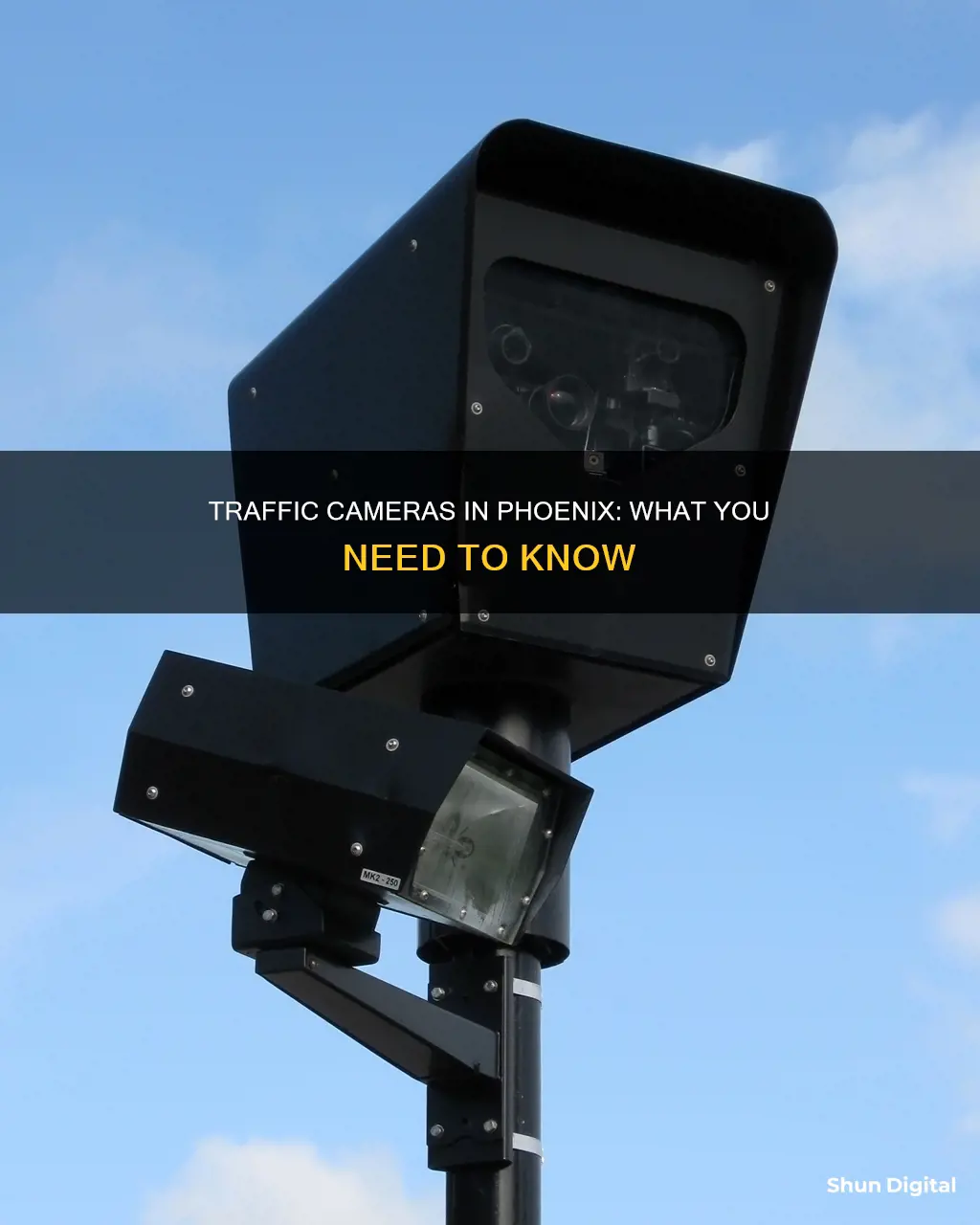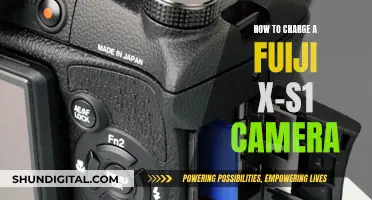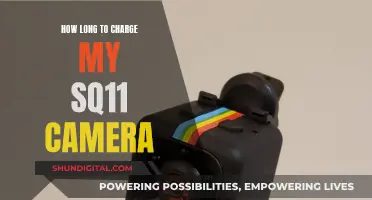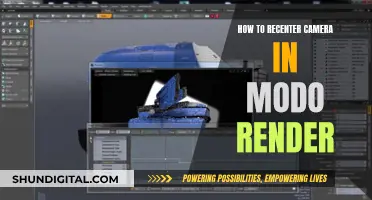
Phoenix, Arizona, has a network of traffic cameras that monitor and manage traffic flow, enhancing road safety and the ease of movement throughout busy areas. The Arizona Department of Transportation (ADOT) has placed more than 400 cameras statewide, with the majority located along the freeways in Phoenix and Tucson. These cameras help manage traffic, especially when accidents block the road. The live traffic feeds are available to the public through az511.gov, and still photos from traffic camera footage can be accessed through the city's official traffic website and partnering agencies.
What You'll Learn
- Phoenix traffic cameras help monitor and manage traffic flow
- Footage is available to the public through az511.gov
- Cameras are placed in areas with heavy traffic and where collisions are likely to occur
- The Arizona Department of Transportation has over 400 cameras statewide
- Red light cameras capture images of vehicles that run red lights

Phoenix traffic cameras help monitor and manage traffic flow
Phoenix, Arizona, has a network of traffic cameras that help monitor and manage traffic flow. These cameras are an invaluable resource for commuters and authorities, providing real-time traffic updates and enhancing road safety.
The Arizona Department of Transportation (ADOT) has positioned more than 400 cameras statewide, with a majority of them located along the freeways in Phoenix and Tucson. These cameras play a crucial role in managing traffic, especially when accidents block the roadway. ADOT dispatchers use live camera feeds to identify problems and dispatch emergency personnel quickly and efficiently.
The general public can also access these live traffic feeds through the az511.gov website or the “nav bug” website for views of I-10. This allows commuters to check for traffic congestion, accidents, or road incidents that may impact their travel plans.
In addition to the ADOT cameras, Phoenix also has red-light cameras and speed cameras. These automated tools are used by law enforcement to monitor and enforce traffic laws. Red-light cameras capture images of vehicles running red lights, while speed cameras detect and record vehicles travelling over the speed limit. These cameras promote road safety and deter dangerous driving behaviours.
To access traffic camera footage for accident investigations or insurance claims, individuals must identify and contact the relevant authority, such as the local police department or the department of transportation. Specific procedures and requirements may vary, but providing detailed information about the incident and following the authority's formal process for requesting footage will increase the likelihood of obtaining the necessary information.
Surveillance Camera Coverage: Understanding the Basics
You may want to see also

Footage is available to the public through az511.gov
Phoenix, Arizona, like many cities, has an extensive network of traffic cameras. These cameras are typically positioned to monitor the busiest roads and intersections, where they can help manage traffic and respond to accidents. The Arizona Department of Transportation (ADOT) has installed more than 400 cameras across the state, most of which are located on the freeways of Phoenix and Tucson.
Footage from these cameras is available to the public through az511.gov. This website provides live traffic feeds, allowing users to view current road conditions and traffic flow. To access these feeds, users can visit the website and either click on a camera icon on the map or select a camera from a list. This will bring up a live view of the selected camera, which can be added to a personalised list of "My Cameras".
In addition to the live feeds, az511.gov also offers other useful features for those planning a route. Users can view information on roadwork, closures, accidents, and special events. Weather alerts, forecasts, and border wait times are also provided. For those seeking more personalised information, it is possible to create an account and save specific routes and cameras. This allows users to quickly access information relevant to their regular journeys or areas of interest.
While az511.gov provides easy access to live traffic camera feeds, obtaining recorded footage may be more challenging. Recorded footage is often retained by law enforcement agencies, such as the City of Phoenix Police Department or the ADOT. These agencies have specific procedures and requirements for the release of surveillance videos, and there is no guarantee that they will provide footage to the public. However, an attorney can assist in issuing a subpoena to demand the release of relevant footage, which can be valuable evidence in car accident claims.
Switching to Night Mode: Enhancing Low-Light Photography
You may want to see also

Cameras are placed in areas with heavy traffic and where collisions are likely to occur
Traffic cameras are an essential tool for monitoring and managing traffic flow, especially in areas with heavy traffic and a high collision risk. These cameras are strategically placed to capture critical traffic data and improve road safety.
In Phoenix, the Arizona Department of Transportation (ADOT) has deployed over 400 cameras, with a majority located along the city's freeways. These cameras serve multiple purposes, including traffic management and emergency response. When accidents occur, ADOT dispatchers use live camera feeds to identify the issue and quickly dispatch emergency services. The public can also access these live traffic feeds through websites like az511.gov.
While real-time monitoring is a primary function of these cameras, they also play a crucial role in collision investigation and prevention. Cameras are typically positioned in areas with heavy traffic and a high likelihood of collisions. This strategic placement allows law enforcement to capture footage of accidents, red-light violations, and speeding incidents. The footage obtained from these cameras can be used as evidence in car accident claims and traffic violation cases.
The placement of cameras in these high-risk areas acts as a deterrent to dangerous driving. The presence of cameras encourages motorists to follow traffic laws and reduces the likelihood of accidents. Additionally, the footage captured by these cameras can help law enforcement identify and locate hit-and-run drivers, leading to increased road safety.
Surveillance cameras are also commonly found on businesses and private residences, and this footage can be invaluable in car accident investigations. These cameras often capture accidents or provide critical details about the moments leading up to a collision. By working with property owners, investigators can access this footage to support their inquiries.
In summary, traffic cameras are strategically placed in areas with heavy traffic and a high collision risk. These cameras serve multiple purposes, including traffic management, emergency response, and collision investigation. The placement of cameras in these critical areas improves road safety, deters dangerous driving, and provides valuable evidence in the event of accidents.
Troubleshooting LG Stylo 4 Camera Focusing Issues
You may want to see also

The Arizona Department of Transportation has over 400 cameras statewide
Phoenix, Arizona, has a comprehensive network of traffic cameras that aid in monitoring and managing the flow of traffic. These cameras are an invaluable resource for both authorities and the public, providing real-time updates and enhancing road safety. The Arizona Department of Transportation (ADOT) has positioned over 400 cameras statewide, with a significant number located in Phoenix and Tucson.
The ADOT Traffic Operations Center utilises these cameras to effectively manage traffic. When a freeway incident occurs, dispatchers can quickly identify the problem through live camera feeds and promptly dispatch emergency personnel. This efficient system helps to ensure that any accidents or roadway issues are promptly addressed, improving traffic flow and safety for commuters.
The majority of these cameras are strategically placed along freeways and at busy intersections in Phoenix and Tucson. This strategic placement allows for efficient traffic management and incident response. The live feeds from these cameras are readily available to the public through the az511.gov website, providing users with real-time traffic updates and details of ongoing incidents, road closures, or construction projects.
To access these live traffic camera feeds in Phoenix, individuals can follow a few simple steps on the Arizona 511 website. By navigating to the "Traffic" section and selecting "Cameras List", users can then filter the cameras by "Area" and "Roadway" to view the relevant live feeds. This information empowers commuters to make informed decisions and plan their routes accordingly.
In addition to the ADOT cameras, Phoenix also utilises red-light cameras and speed cameras for traffic enforcement. These automated tools capture images of vehicles running red lights or exceeding speed limits, serving as a deterrent against dangerous driving behaviours and promoting road safety. The locations of these cameras can be found on maps and guides, helping drivers stay informed and avoid costly fines.
Side-View Cameras: Which Cars Have This Futuristic Feature?
You may want to see also

Red light cameras capture images of vehicles that run red lights
Red light cameras are a type of traffic enforcement camera that captures images of vehicles that run red lights. They are installed at intersections to monitor vehicles passing through and are synchronized with the traffic signals to catch drivers who fail to stop when the light is red. These cameras are triggered by sensors installed in the road, which detect when a vehicle enters an intersection after the traffic signal has turned red. The cameras then take several pictures of the offending vehicle, which can be used as evidence by law enforcement to enforce traffic laws.
In Phoenix, Arizona, red light cameras are used to enforce traffic laws and improve road safety. The Arizona Department of Transportation (ADOT) manages the state's traffic camera system, with over 400 cameras positioned statewide, mainly located along the freeways in Phoenix and Tucson. While live traffic feeds from these cameras are accessible to the public, obtaining recorded footage may be more challenging and may require a subpoena.
Red light cameras are typically triggered when a vehicle enters an intersection after the traffic signal has turned red. However, the specifics of how these cameras operate may vary from state to state. In some states, the cameras may capture images of the driver's face, while in others, only the rear of the vehicle is photographed to protect the driver's privacy.
When a vehicle is caught running a red light by a red light camera, the owner of the vehicle typically receives a citation or ticket in the mail. This ticket includes photographs of the violation, along with details such as the date, time, location, vehicle speed, and the amount of time elapsed since the light turned red. The owner of the vehicle may then be required to pay a fine or face other legal consequences.
While red light cameras are intended to improve road safety and reduce crashes, there is ongoing debate about their effectiveness. Some studies suggest that they can reduce right-angle crashes and related injuries, but they may also lead to an increase in rear-end collisions as drivers abruptly stop to avoid a ticket. Additionally, there are concerns about the financial motivations behind the use of these cameras, with opponents arguing that they are more about generating revenue than enhancing public safety.
Charging the Kodak EasyShare M22: A Step-by-Step Guide
You may want to see also
Frequently asked questions
Yes, Phoenix, Arizona, has a network of traffic cameras that monitor and manage traffic flow.
The Arizona Department of Transportation (ADOT) has positioned more than 400 cameras statewide, with the majority located along the freeways in Phoenix and Tucson.
Traffic cameras help enhance road safety and ease of movement in busy areas. They also provide valuable footage to authorities and the public, aiding in accident investigations and traffic management.
Recent still photos from traffic camera footage in Phoenix are accessible through the city's official traffic website, az511.gov, and partnering agencies. Live traffic feeds are also available to the public through this website.
Yes, you can request copies of traffic camera videos by identifying and contacting the relevant authority, such as the local police department or the Arizona Department of Transportation (ADOT). However, the process may vary, and certain steps must be followed to ensure compliance with privacy laws and the timely processing of your request.







